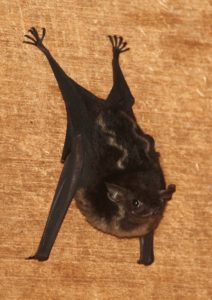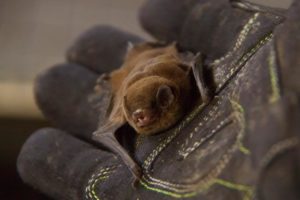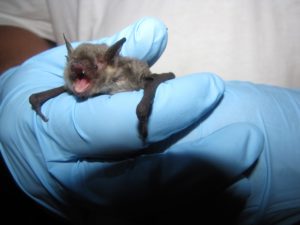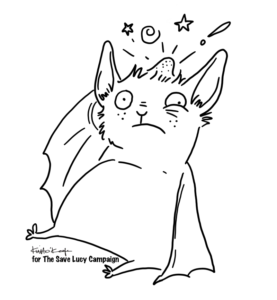
Hi everyone! I hope you all had a good week! Yesterday, a dam at an iron-ore mine in Brazil collapsed. Because of this disaster, I thought I would research a bat from Brazil. I found a very cute bat! It looks like a shrew that knows something you don’t. It’s called the Greater sac-winged bat. In addition to Brazil, these bats live in several other Central and South American countries. Their range is from central Mexico, through Central America, into South America. They live in the South American countries of Brazil, Bolivia, Guyana, Suriname, Guyane, and the Antillean islands. The Greater sac-winged bat has dark brown fur, and some have zig-zag stripes on their back. They have long noses and upper lips that are very mobile. They get their name from the small sacs or pouches on their wings. While grooming themselves, the males fill their sacs with drops of urine and glandular secretions. When they are trying to attract a female, the male will hover over her and flap the scent in their sacs toward her. They will also use this technique to ward off other bats from outside their territory. Another interesting fact about these bats is that their pups babble. They will vocalize calls and other sounds, but jumbled up just like a human baby’s babbles. This is the first mammal that is not a primate to be seen babbling. If you’d like to read more about the Greater sac-winged bat, you can find information here.

Hello everyone! I hope you all had a good week. I had a pretty good one because it started with a snow day. That’s right, it finally snowed! While it has been cold and wintery here in the US, people in Australia are in the middle of summer. And with Australian summers, come fires. Because there are so many fires burning in Australia right now, I decided to research an Australian bat. There is a cute little bat called the Chocolate Wattled Bat. Unlike most bats living in Australia, these bats are micro-bats! They have milk-chocolate brown fur, which is where they get their name. They also have a pink nose and a cute, squishy face. They like to roost under bark and in tree hollows in south-western Australia. Their diet consists of moths and beetles. And the Chocolate Wattled Bat will hibernate in the winter when the insects aren’t always around. Although south-western Australia isn’t known for being cold, it does get chilly. And with food scarce, they can’t eat enough to keep them warm. These bats do have a few predators including hawks, owls, cats, wildfires, and humans. If you would like to read more about the Chocolate Wattled Bat, you can find information here and here.

Hi everyone! I hope you all had a good week. It hasn’t been a very good week for National Parks and the plants and animals that live in them. That’s because the government shutdown continues. Many parks around the country are closed, but some remain open. Many of the parks that are open are suffering because of the lack of employees working at the park. Parks are being vandalized and trash is piling up. Sadly, vandals have even killed trees at Joshua Tree National Park. There are other effects of the shutdown too. Because government employees are not allowed to report to work, wildlife conservation and research has been put on hold. That means that government research on White-Nose Syndrome in bats has been halted. Luckily, not all government work has stopped. The US Fish and Wildlife Service has halted construction on 16 miles of Oklahoma Highway 16 between the town of Okay and the city of Wagoner. The work has been stopped to give investigators time to determine whether the construction will affect endangered Gray Bats in the area. Research is needed to determine whether or not sediment from the road construction has been affecting the quality of the water in the area. This could reduce the number of insects in the area, which would affect the bat’s ability to find food. If you would like to read more about this, you can find information here. I hope everyone has a good week. And, please, if you are fortunate enough to be allowed onto National Park land during this shutdown, take care of our parks. Please pick up your trash, stay on trails, and respect the plants and animals who live there.

Hi everyone! I hope you all had a good week and a happy New Year! To kick off the new year, I thought I would make this a happy blog post. I found a lovely article about a recently recovered bat in the Salthaven West Wildlife and Education Center in Saskatchewan, Canada. He is an adorable Big Brown bat that will be released this May. He had very severe injuries when he came in, including a facial injury that rehabbers think came from a fight with another male bat. The injury had healed, but it left a bad scar. Because of this scar, his rehabbers named him Scarface. Despite his scary name, Scarface is very calm and happy for all the help he is receiving. He is staying in an enclosure much like the ones we have here at Save Lucy. The enclosure has a few other male bats, and some places for them to hang, hide and climb. The bats at the Center are kept awake all winter, even though they would be hibernating out in the wild. They get fed lots of mealworms to keep them happy and well fed. The bats at the Center are usually released back into the wild sometime in May, as long as they don’t still need help recovering from whatever brought them there in the first place. This year, Scarface will join the pack and fly back to his family. If you would like to read more about little Scarface, you can find the article here. I hope you all have a fantastic week! Happy New Year!



